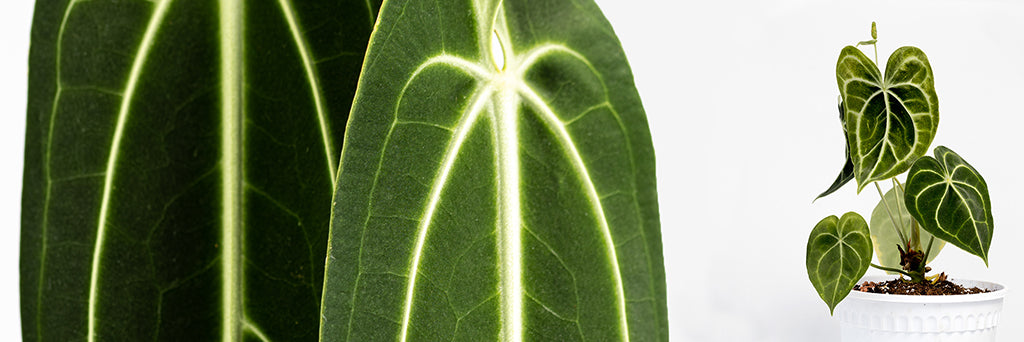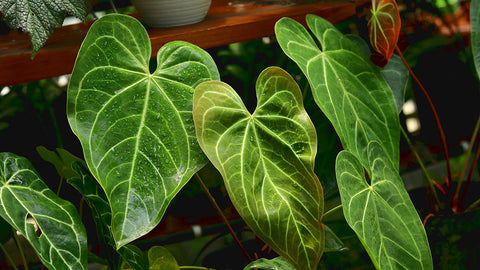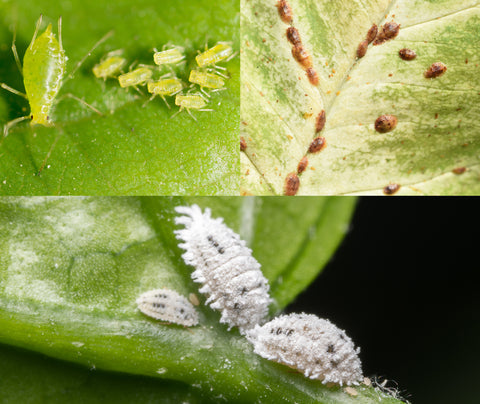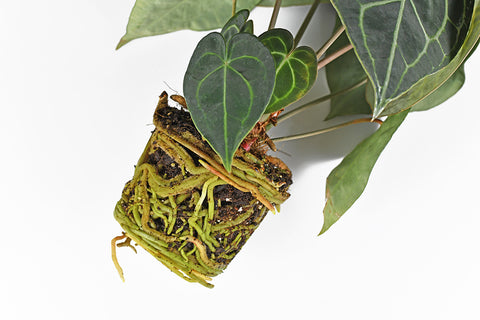Anthurium Plant Care Guide
HOW TO GROW AND CARE FOR ANTHURIUMS

| Common Varieties | Anthurium clarinervium, Anthurium veitchii (King Anthurium), Anthurium warocqueanum (Queen Anthurium), Anthurium Crystallinum, Anthurium magnificum, and Anthurium forgetii. |
| Botanical Name | Anthurium spp. |
| Family | Araceae |
| Plant Type | Tropical flowering plant |
| Mature Size | Varies by species, typically compact |
| Light | Bright, indirect light |
| Soil Type | Well-draining, aerated mix |
| Native Areas | Tropical regions of Central and South America |
| Toxicity | May be toxic if ingested, and the sap can be a skin and eye irritant. |
Anthuriums, belonging to the Araceae family, a genus of plant species admired for their vibrant blooms and attractive foliage. Native to tropical regions in Central and South America, they are not only popular houseplants, but they are also often used in floral arrangements due to their long-lasting blooms.
Anthurium leaves are particularly loved, with some glossy and reflective, while others are velvet, and their unique shapes can vary widely between different species and cultivars, such as heart-shaped or elongated leaves that may be solid green or variegated with splashes of white, pink, or red. To thrive, Anthuriums require warm, humid conditions and bright, indirect light, regular watering, and good fertilisation. With proper care, they can add a stunning display of colour and beauty to any home.
Our Anthurium Plant Care Guide will provide all the information you need to keep your Anthurium thriving! We will give you the tips on Anthurium light and temperature needs, watering, fertilising, and how to propagate your plants. Let's embark on the journey of Anthurium plant care together!
WELCOME TO YOUR ANTHURIUM PLANT CARE GUIDE

HOW MUCH LIGHT DOES AN ANTHURIUM NEED?
Anthuriums are tropical plants that need bright, indirect sunlight to thrive. They will do best in bright, diffused sunlight, but not direct sunlight as it can burn the leaves. Place Anthuriums in a spot that receives at least four hours of bright, indirect sunlight each day and if possible, try to rotate the plant every few days to ensure even growth. If you provide your plants with too little light they may become leggy and flop over, so make sure you give them enough light to stay healthy and strong.

HOW OFTEN SHOULD I WATER AN ANTHURIUM?
Anthuriums require consistent watering to stay healthy. You can allow the top few centimetres of soil to dry out almost completely between waterings. Typically, in the growing season, you would water your Anthurium once a week to once a fortnight depending on its environment. When you water your Anthurium, water it thoroughly - until water runs out of the bottom of the pot - and then discard any excess water that collects in the drip tray. If you notice the leaves drooping and curling, this could signify that your Anthurium needs more water. You can also feel to see if the soil is still moist. When in doubt, err on the side of underwatering to avoid over-watering and potential root rot.
WHAT IS THE BEST POTTING MEDIUM FOR ANTHURIUM?
The best potting medium for Anthurium is one with a well-draining, aerated composition such as a chunky aroid mix. A good mix should consist of 20% peat moss, 20% perlite, and 60% chunky orchid bark. This combination will allow for adequate drainage and air circulation while providing moisture and nutrients for the Anthurium's roots. To promote healthy growth, the aroid mix should also be slightly acidic, with a pH of around 5.5 to 6.5. Additionally, the potting medium should be moist but not soggy, as too much moisture can cause the roots to rot. If using a potting mix from a garden centre, check the label for the ingredients and pH level and choose a chunky mix such as a mix for orchids.
WHAT IS THE BEST TEMPERATURE FOR ANTHURIUM TO THRIVE?
The ideal temperature for Anthurium to thrive in is between 18-23°C. It is important to keep the temperature consistent and avoid any drastic fluctuations. The Anthurium thrive in humidity level of around 60-70% or higher. If the temperature is too cold, the foliage will start to yellow and wilt, while if it is too hot, the plant may suffer from heat stress.
WHAT IS THE BEST HUMIDITY FOR ANTHURIUM?
An ideal humidity level for an anthurium is between 60 to 70 percent or higher. This can be achieved by setting up a humidifier near the plant or grouping plants together.
TRAINING ANTHURIUM ONTO A POLE FOR SUPPORT
You might need to attach your Anthurium onto a pole for support. First, choose a sturdy pole to support the Anthurium. Then, tie the Anthurium onto the pole with plant velcro. Begin by attaching the velcro close to the base of the Anthurium and gradually work your way up the stem. This will provide the Anthurium with additional support as it grows. As your Anthurium grows, continue to tie it securely to the pole.
WHAT'S THE BEST FERTILISER FOR ANTHURIUM?

We use the Growth Technology, Foliage Focus on all our Anthurium plants from seedlings to mature plants. Follow the bottle instructions to mix the fertiliser to the strength required for the age of your plant.
WHY USE GROWTH TECHNOLOGY FOLIAGE FOCUS?
The GT Focus range sets the benchmark for liquid nutrients. Here's why:
• Each GT Focus product is complete. Unlike most fertilisers, all Focus products contain each of the 12 essential minerals – including Calcium – blended into an easily absorbed liquid concentrate.
• pH buffered to ensure all 12 essential minerals are available to the plant.
• Formulated and balanced to suit the requirements of specific plant types.
• Manufactured using only the highest-grade raw materials and chelated trace elements to ensure effortless absorption by the plant.
• Guaranteed not to contain potentially harmful and ineffective chlorides, urea, sodium and ammonium.
• Easy to use with simple instructions.
• Makes up to 200 litres of working solution
WHAT ARE COMMON ANTHURIUM PESTS, AND HOW DO YOU TREAT THEM?
Anthuriums are susceptible to mites, scale, mealybugs, aphids, and thrips. To treat these pests, it is essential to inspect your plant regularly and act as soon as you notice any signs of infestation. Keep your Anthurium away from other plants that may have pests to prevent problems. If you do have pests, you can treat them with insecticidal soap, neem oil, and horticultural oil. Make sure to follow the directions on the label and apply the treatments as needed. To ensure the pests are eliminated, you may need to repeat the treatments a few times. Additionally, beneficial insects such as ladybugs, lacewings, and parasitic wasps can be effective biological control against these pests.


HOW TO PRUNE AN ANTHURIUM
It is essential to use clean and sharp pruning shears when pruning any plants. Most Anthurium won’t need pruning, but you will need to remove any dead, damaged, or diseased leaves. Trim off any brown or yellowing leaves and be sure to leave a few leaves on the plant so that it can continue to photosynthesise. Cut back any stems that appear to be overgrown or tangled and any long stems that are growing away from the plant's central crown. This will help to maintain the overall shape and encourage new growth.
HOW TO PROPAGATE AN ANTHURIUM?
Anthurium can be easy to propagate. Start by cutting off a stem with at least two nodes (growth points). Remove any leaves and flowers from the stem before cutting it. Then, dip the cutting in the rooting hormone to stimulate root growth. Plant the cutting in a pot filled with a well-draining potting mix and water it regularly. Place the pot in a warm, humid location where it can get indirect sunlight. The cutting should take root in a few weeks, and you can then transplant it into a larger pot. You can also use soilless mediums to propagate Anthurium such as Sphagnum Moss, Perlite or Vermiculite. Anthuriums can be grown from seed! When your Anthurium matures it may produce info’s which you can pollenate.

WHEN DO YOU NEED TO REPOT AN ANTHURIUM?
Anthuriums should be re-potted every two to three years or when the roots start to outgrow the container. When repotting, use a pot with drainage holes, fill it with fresh aroid mix, and make sure the plant's root system is not root-bound before planting. Place the Anthurium in the pot, fill it with mix, and gently pat down the medium. Water the plant deeply and allow any excess water to drain away. Finally, place the Anthurium in a well-lit spot where it will receive indirect sunlight.
WHAT SORT OF POT DO ANTHURIUMS LIKE?
Anthuriums need a pot with good drainage. The pot should have several drainage holes in the bottom and sometimes the sides, as anthuriums do not like to sit in soggy medium for too long. Plastic pots are preferred over clay pots because they are better at retaining moisture.
📷 Anthurium clarinervium, Chalet Boutique
ARE ANTHURIUMS TOXIC TO PETS AND CHILDREN?
Anthuriums can be toxic to pets and children if ingested. The plant contains calcium oxalate crystals which can cause oral irritation, excessive drooling, vomiting, and difficulty swallowing if ingested. While the plant itself is not poisonous, the sap from the plant can be an irritant to the skin and eyes. If you have children or pets in your home, keeping anthuriums out of reach is best to avoid any potential danger.

Strap-leaf Anthurium
Strap-leaf Anthuriums, such as Anthurium Vittarifolium, Anthurium Pendulifolium, Anthurium bakeri, Anthurium gracile, Anthurium wendlingeri, and Anthurium friedrichsthalii, are epiphytic plants that are known for their elongated foliage and suitability for hanging baskets. These plants have similar care requirements to other epiphytic Anthuriums, requiring good drainage and a well-aerated growing medium. They prefer bright, indirect light and high humidity, which can be achieved by misting the foliage regularly or using a humidifier. Like other Anthuriums, it's important not to overwater strap-leaf Anthuriums, allowing the top inch of soil to dry out before watering again. With the proper care, these plants can produce beautiful, elongated leaves and add a unique touch to any indoor garden.
A LIST OF WELL KNOWN ANTHURIUMS
Anthurium bakeri
Anthurium balaoanum
Anthurium clarinervium
Anthurium crystallinum
Anthurium dorayaki
Anthurium dressleri
Anthurium faustomirandae
Anthurium forgetii
Anthurium friedrichsthalii
Anthurium gracile
Anthurium hookeri
Anthurium longilaminatum
Anthurium luxurians
Anthurium magnificum
Anthurium papillilaminum
Anthurium pentaphyllum
Anthurium podophyllum
Anthurium radicans
Anthurium regale
Anthurium superbum
Anthurium veitchii
Anthurium vittarifolium
Anthurium warocqueanum
Anthurium watermaliense
Anthurium wendlingeri











Comments
Alice said:
Very interesting and informative.